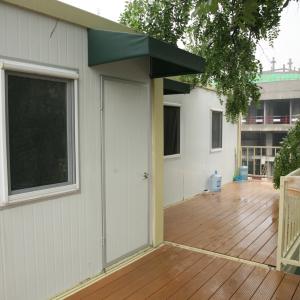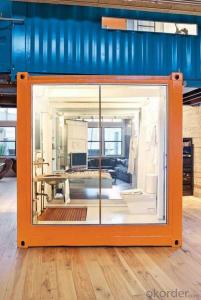Luxury prefabricated container house
OKorder Service Pledge
Quality Product, Order Online Tracking, Timely Delivery
OKorder Financial Service
Credit Rating, Credit Services, Credit Purchasing
You Might Also Like
Specifications
Prefab Container Home:
1. excellent design
2. can be customized
3. ISO9001:2008
4. long availability
Prefab Container Home
We mainly manufacture prefab house, container house, light steel villa, steel structure building, and sentry boxsince 2005.

USAGE: mobile living house, mobile office, mobile toilet, dormitory, school etc
- Q: Are container houses suitable for individuals with allergies or sensitivities?
- Depending on various factors, container houses can be a viable choice for individuals who have allergies or sensitivities. One advantage of these houses is their ability to be constructed using non-toxic and hypoallergenic materials, which can decrease the likelihood of triggering allergies or sensitivities. Additionally, the construction process allows for better control over ventilation, aiding in the filtration of allergens and the maintenance of air quality. Nevertheless, it is essential to take into account the source of the container, as some may have previously transported goods that could have contained allergens or irritants. It is imperative to thoroughly clean and treat the container to ensure it is safe for individuals with allergies or sensitivities. Moreover, the suitability of a container house for individuals with allergies or sensitivities greatly depends on its location and the surrounding environment. If the house is situated in an area with high levels of pollen, dust, or other allergens, it may still present challenges. Therefore, it is crucial to consider factors such as the local climate, air quality, and potential exposure to allergens when contemplating a container house for someone with allergies or sensitivities. Ultimately, determining whether a container house is appropriate for individuals with allergies or sensitivities requires careful consideration of these factors, utilization of proper construction techniques, and the incorporation of hypoallergenic materials to establish a safe and healthy living environment.
- Q: Can container houses be soundproofed?
- Soundproofing container houses is indeed possible. Although shipping containers are not originally designed to be soundproof, there are various methods and techniques that can be utilized to enhance their acoustic insulation. A commonly used approach involves incorporating insulation materials like fiberglass or mineral wool into the walls, floors, and ceilings of the container. These materials effectively absorb and minimize sound transmission, thereby increasing the soundproofing of the container. Additionally, sealing any gaps or openings in the container's structure can also contribute to preventing sound leakage. Another effective method entails the installation of double-pane or laminated glass windows, which are specifically designed to minimize sound transmission. These windows consist of a layer of air or sound-absorbing material between the glass panes, creating a barrier against noise. Furthermore, the addition of acoustically rated doors with weatherstripping can further enhance the soundproofing capabilities of container houses. These doors are specially designed to minimize sound transfer and can be equipped with seals to prevent any sound leaks. It is important to acknowledge that achieving complete soundproofing may be challenging, as it depends on factors such as the desired level of insulation, the specific container structure, and the surrounding environment. Seeking advice from professionals or acoustic engineers can be beneficial in determining the most suitable soundproofing solutions for container houses.
- Q: Are container houses suitable for urban living?
- Yes, container houses can be suitable for urban living. They offer a cost-effective and sustainable solution to housing shortages in urban areas. Container houses are compact, customizable, and can be easily stacked or arranged to maximize space in crowded cities. Additionally, their modular nature allows for quick construction and flexibility in design. However, factors such as local regulations, infrastructure, and aesthetics should be considered to ensure their suitability in specific urban contexts.
- Q: Are container houses suitable for vacation homes or cabins?
- Indeed, container houses have the potential to serve as excellent vacation homes or cabins. The rising popularity of container houses for this purpose can be attributed to their versatility, affordability, and sustainability. Whether a small and cozy space or a lavish retreat is desired, container houses can be easily tailored to meet specific vacation home or cabin requirements. Container houses possess a distinct and contemporary aesthetic that seamlessly harmonizes with natural surroundings, making them an ideal choice for vacation homes or cabins situated in picturesque locations. They can be designed to optimize natural light and offer breathtaking panoramic views of the surrounding landscape. In terms of cost-effectiveness, container houses generally prove to be more economical than conventional vacation homes or cabins. The expense of procuring and transforming a shipping container into a habitable abode is considerably lower when compared to constructing a traditional structure. This affordability holds particular appeal for those seeking a budget-friendly option for their vacation home or cabin. Furthermore, container houses are environmentally friendly and sustainable. By repurposing shipping containers, we can contribute to waste reduction and lessen the environmental impact of construction. Container homes can also be designed to be energy-efficient, incorporating features such as insulation, solar panels, and rainwater harvesting systems, thus reducing their carbon footprint. While container houses present themselves as suitable choices for vacation homes or cabins, it is crucial to consider certain factors before making a final decision. Factors such as container size, adherence to zoning regulations, and the availability of utilities and services in the desired location should be carefully weighed. Nevertheless, with meticulous planning and customization, container houses can offer a distinctive and comfortable vacation home or cabin experience.
- Q: Can container houses be designed with a home gym or fitness area?
- Certainly, container houses can be specifically designed to include a home gym or fitness area. These types of homes are highly customizable, allowing homeowners to meet their individual needs and preferences. Many individuals who prioritize their health and fitness choose to add a home gym or fitness area to their container house. The compact nature of containers actually lends itself well to creating a functional and efficient space for exercising. To create a container house with a home gym or fitness area, certain factors must be taken into consideration. Firstly, the size of the container will determine the amount of space available for the gym. Containers come in various sizes, so selecting a larger one will provide more room for equipment and workout space. It is also essential to ensure that the container is properly insulated and ventilated to create a comfortable environment for exercising. The layout of the gym area should be carefully planned to make the best use of the available space. This might involve incorporating adjustable workout equipment, such as foldable benches or wall-mounted racks, to save space when not in use. Utilizing vertical space by installing wall-mounted storage units or racks can also help optimize the gym area. When designing a container house with a home gym or fitness area, it is crucial to consider the structural integrity of the container. It may be necessary to reinforce the structure to support the added weight of gym equipment and ensure the safety of the occupants. In conclusion, container houses offer great potential for including a home gym or fitness area. With proper planning and design, container homes can provide functional and stylish spaces that promote health and wellness.
- Q: Are container houses prone to condensation or humidity issues?
- Container houses are not inherently prone to condensation or humidity issues. However, proper insulation, ventilation, and moisture control measures need to be implemented during construction to prevent these problems. With the right precautions, container houses can effectively manage condensation and humidity levels just like traditional houses.
- Q: Can container houses be designed to have a rooftop bar?
- Yes, container houses can be designed to have a rooftop bar. With proper planning and design, it is possible to incorporate a rooftop bar into a container house. The strength and structural integrity of the containers can be reinforced to support the weight of a rooftop bar. Additionally, modifications can be made to create a spacious and comfortable rooftop area, complete with seating, a bar counter, and even a small kitchenette. The containers can be stacked or arranged in a way that allows for easy access to the rooftop area, ensuring a seamless transition between the interior and the rooftop bar. By utilizing creative design and engineering techniques, container houses can be transformed into unique and stylish spaces that include a rooftop bar.
- Q: Can container houses be designed to have a built-in storage space?
- Yes, container houses can definitely be designed to have a built-in storage space. In fact, one of the advantages of using shipping containers for construction is their inherent storage capacity. The design of container houses allows for various storage solutions, both inside and outside the container. Internally, the walls of the container can be modified to incorporate shelves, cabinets, and even closets to maximize storage space. These can be custom-built to fit the specific needs and preferences of the homeowner. Additionally, the container itself offers ample space to store various items, such as furniture, appliances, or personal belongings. Externally, the space around the container can also be utilized for storage purposes. This can be achieved by adding storage sheds, attaching hooks or racks to the container walls, or even creating additional storage compartments within the landscaping design. Overall, container houses are highly versatile and can be designed to provide ample storage space, allowing homeowners to efficiently organize their belongings and make the most of the available area.
- Q: Are container houses suitable for art galleries?
- Yes, container houses can be suitable for art galleries. They provide a unique and adaptable space that can be customized to meet the specific needs of an art gallery. With proper design and modifications, container houses can offer a cost-effective and creative solution for displaying artwork, while also fostering a modern and innovative atmosphere.
- Q: Can container houses be designed to have a rustic or industrial look?
- Certainly, container houses can be designed with a rustic or industrial appearance, thanks to the versatility of shipping containers. This allows for a wide range of design possibilities and aesthetics. To achieve a rustic look, modifications to container houses can include using reclaimed wood siding, vintage fixtures, and earthy color palettes. These choices create a warm, cozy, and natural atmosphere. Furthermore, incorporating elements like exposed beams, distressed finishes, and vintage-inspired furnishings can further enhance the rustic vibe. In a similar vein, container houses can be transformed into industrial-style homes. Industrial design often showcases exposed brick, concrete, and metal elements. By leaving the container walls unfinished or utilizing materials like corrugated metal, the desired industrial aesthetic can be easily achieved. The use of industrial lighting fixtures, minimalistic furniture, and a monochromatic color scheme can complete the overall look. The key to achieving a rustic or industrial appearance in a container house lies in the careful selection of materials, finishes, and furnishings that align with the desired aesthetic. With the right design choices, container houses can be transformed into unique and stylish homes that radiate a rustic or industrial vibe.
Send your message to us
Luxury prefabricated container house
OKorder Service Pledge
Quality Product, Order Online Tracking, Timely Delivery
OKorder Financial Service
Credit Rating, Credit Services, Credit Purchasing
Similar products
Hot products
Hot Searches
Related keywords























